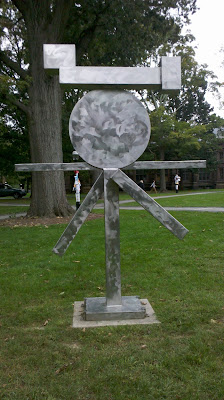Syllabus
Mount Saint Mary College
Sculpture II
Course Number: ART 3010 Credits: 3
Course Title: Sculpture II
Professor: Gary Jacketti
Office Hours: Tuesday, Thursday before or after class
e-mail: gjac4166@msmc.edu
Class Times: Tuesday/Thursday 5:15 to 6:40
Course Outcomes: The objective of this course is to continue the development of personal expression through sculpture. The course will reflect on the influences and conventions of sculpture beginning with the dawn of time through Contemporary Art. The students will begin to develop personal avenues of expression using various techniques and mediums of sculpture. The emphasis will be on this personal development and its impact on works in studies as well as finished sculptures.
Grading and Evaluation
Students will need to complete 2 major projects. They will also present accompanying studies and intellectual research to substantiate these finished sculptures. Studies from life and personal interests will be a major component of their work, therefore attendance is mandatory. Five unexcused missed classes will result in the dropping of the letter grade by 1. I will evaluate the content as follows:
Mid-Term Sculpture 25%
Blog 15%
Sculpture Studies 35%
Final Sculpture 25%
Division of Arts and Letters Grading Policy
Points
|
Grade Equivalent
|
Quality Points
|
Meaning
|
100-95
|
A
|
4.0
|
Superior
|
94-90
|
A-
|
3.67
|
Outstanding
|
89-87
|
B+
|
3.33
|
Excellent
|
86-83
|
B
|
3.0
|
Very Good
|
82-80
|
B-
|
2.67
|
Good
|
79-77
|
C+
|
2.33
|
Above Average
|
76-73
|
C
|
2.0
|
Average
|
72-70
|
C-
|
1.67
|
Below Average
|
69-65
|
D+
|
1.33
|
Poor
|
64-60
|
D
|
1.0
|
Passing
|
59-0
|
F
|
0.0
|
Failing
|
Blog
You will be responsible for a weekly blog post related to your personal avenue of expression. Historical and contemporary sculptors should be used as influence and inspiration.
Critiques
Your finished major sculptures will be looked at and discussed critically with your peers. Attendance and participation is mandatory. This is one of the most important tools artists use to help reflect and improve their work. I will be available for one private critique for each project to be scheduled during the semester.
Sculpture Studies
These studies or maquettes will consume a great amount of studio time during the semester. They will be used to improve technique and as a guide through experimentation and exploration. They should show a cohesive and substantial thought process and become more directly integrated to the 2 major sculpture projects.
Mid Term and Final Sculptures
These sculptures are finished complex and take a great amount of time to develop. They will be worked on during the semester on a continual basis. The growth of the individual will be evident in their creative endeavors. The second part of the semester will develop with the student’s choice of sculptor to research and develop their work in accordance with their chosen artist’s theme.
Week 6 and 7
Group Critiques for midterm maquettes and sculptures
Week 8
Mid Term Critique
Week 13 and 14
Group Critiques for final maquettes and sculptures
Week 15
Final Critique


































